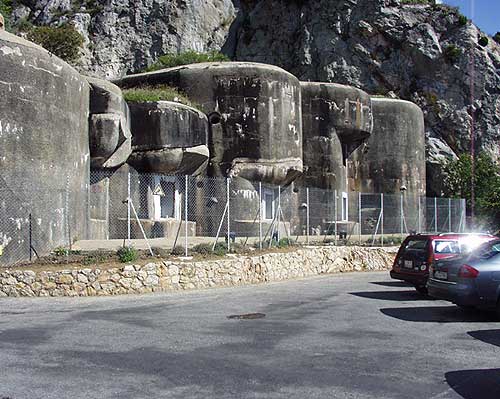
Gros ouvrage de Ste-Agnès - 6 blocs - Located E of Ste-Agnès. Access from Ste-Agnès. From the village centre go South to the belvedere. Currently opened to the public.

ST. AGNES (2450 feet above sea level) ,the museum opens daily (in the summer) at 3pm. Our French guide, Mr. Ray, was very knowledgeable about St. Agnes and interested in the Maginot Line in general. He gave us a very long and detailed tour and by the time we emerged we had seen almost all of this well preserved and well restored ouvrage.
We started the tour with a short film about
the village of St. Agnes and the fort, luckily and surprisingly it had
English sub titles. The fort had been maintained and occupied by the army
until the end of the cold war. It had been retained as it might be
required as a nuclear fallout shelter or a nuclear proof command centre.
In the early 1990's it was handed over to the village and now run as a
tourist attraction. When fully manned the fort would have held 280 troops.
We were able to see three of the 4 blocks, Block 1 is the entrance block.
It was explained to us that although the Gros Ouvrages in the Alps
generally have internal tramways for moving ammunition around, because of
the compact nature of the forts and the close proximity of the fighting
blocks to the entrance they are all hand pushed tramways rather than the
overhead electric traction employed in many of the larger forts further
north. Another major difference is that all the Gros Ouvrages we saw had
an entrance drawbridge over the fosse (usually found raised) and a smaller
men's entrance alongside with a removable footbridge across to a steel
door. Drawbridges are not seen at the northern forts.
Immediately inside the entrance the generator room is to the left with its
three marine generators and compressors in excellent working order. On the
opposite side of the corridor is the large filter room with two banks of
carbon filters in large cylinders along both walls. Beyond these is a
junction to the right leading to Block 2 and beyond that on the right hand
side of the main corridor the 'caserne' with all the domestic and
command rooms. Some of the dormitories still had their bed frames while
others had replacement wooden boards across the frames. This area included
fully equipped workshop, kitchen, toilets, washing area, an infirmary with
original beds and screens (much of the other equipment here came from a
local clinic). Probably of most interest was the command centre consisting
of several rooms (including a telephone exchange) with situation boards,
telephones, a safe and a mechanical signalling device for contacting each
block with orders; where and when to fire. The blocks would then signal
back to the command centre that they had received these orders. Because of
the noise a visual device was essential. We were able to climb up to Block
3 to see the 75 guns and 81 mm mortars that were still in place on two
levels. We also saw Block 2 which is the largest fighting block on the
Maginot Line and the only one consisting of three levels. Again all the
gun, both mortars and canons were still in place. Our tour ended at this
point and we returned to the entrance.